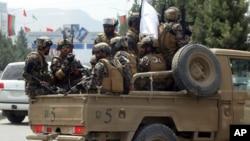Russia may be turning to more countries to resupply its military fighting in Ukraine, but the White House says it has no evidence to support published reports claiming that Moscow has asked the Afghan Taliban for help.
“I can't confirm this report,” John Kirby, coordinator for strategic communications at the National Security Council, told VOA during a briefing Friday. “But if it's true, it certainly would fly in the face of what the Taliban say their goals are,” he added, pointing to the Taliban’s desire to be recognized internationally as the legitimate government in Afghanistan.
A 2022 Pentagon report confirmed that the fall of the U.S.-backed Afghan government following the August 2021 chaotic withdrawal of Western forces gave Taliban fighters access to more than $7 billion worth of American military equipment, what was left of $18.6 billion worth of weapons and other gear provided to the Afghan National Defense and Security Forces from 2005 through August 2021.
The stockpile includes aircraft, vehicles, munitions, guns, communication equipment and other gear that Kirby and other officials emphasized was the property of the now-defunct Afghan government, not the United States. Most of the equipment used by American troops in Afghanistan was retrograded or destroyed, according to the Pentagon.
“We don't have any indication of exactly where all those systems [in Taliban hands] are, how they're being used,” Kirby said. “Certainly, we don't have any indications that the Taliban is willing to export them.”
Zia Ahmad Takal, deputy spokesperson for the Afghan Ministry of Foreign Affairs, denied that the Taliban are providing Russia with weapons. Reports on the "demands for weapons is a lie,” he told VOA.
Attractive target
American weapons now in the hands of the Taliban are an attractive target for various actors looking for firepower.
“You're going to have a lot of outside actors trying to poke around and get access to all of these weapons,” said Michael Kugelman, deputy director of the Asia Program at the Wilson Center, a global policy research group in Washington.
“Whether the Taliban would actually be willing to provide these weapons to Russia, that to me seems a bit hard to believe,” he told VOA.
While an offer from Moscow cannot be ruled out, Kugelman said the Taliban are focused on building up their own military capacity. The group faces internal security threats from terrorist groups such as the Islamic State group and various others, including the National Resistance Front.
Additionally, the Taliban armory may not be of much use for President Vladimir Putin’s war ambitions, since there aren’t many weapons that would be useful in the war in Ukraine, where Russia relies heavily on long-range attacks using unguided weapons, like howitzers and artillery rockets.
What Moscow needs most are missiles and Soviet-standard artillery ammunition, neither of which the U.S. left in Afghanistan, said Mark Cancian, a senior adviser with the International Security Program at the Center for Strategic and International Studies, a Washington think tank.
“Most of the weaponry that the United States left is probably inoperable and badly deteriorated for lack of trained maintainers and spare parts,” Cancian told VOA. “This is particularly true of complex weapons like helicopters or tanks, even those that are Soviet standard.”
Moscow might be able to use military helicopters, including the Soviet-designed Mi-17 that the Taliban currently possess, as well as a limited number of American-made Black Hawks and light planes, but the chances are slim.
“Why would they give them up?” said Jonathan Schroden, director of the Countering Threats and Challenges Program at the Center for Naval Analyses in Arlington County, Virginia. “They'd be giving up the bulk of their air capacity, and I just don't see it being in the Taliban interests to do that.”
Schroden said that the rest of the equipment, including Humvees, heavy machine guns and ammunition, are not necessarily compatible with Russian logistics and maintenance capabilities.
“I don't understand why they would add that to their level of difficulty to what they're already dealing with,” he said.
Almost a year into its invasion of Ukraine, Moscow has turned to other states, including Iran and North Korea, to sustain its military.
Washington has placed sanctions on Tehran for providing Moscow with Iranian-manufactured drones and is attempting to add sanctions on North Korea for supplying battlefield missiles and rockets to the Russian mercenary group Wagner for use in Ukraine.
Tehran has said the drones were sent before Russia's February invasion, and Moscow has denied its forces used Iranian drones in Ukraine. North Korea and Wagner have also rejected U.S. allegations.
Sayed Aziz Rahman contributed to this report.








